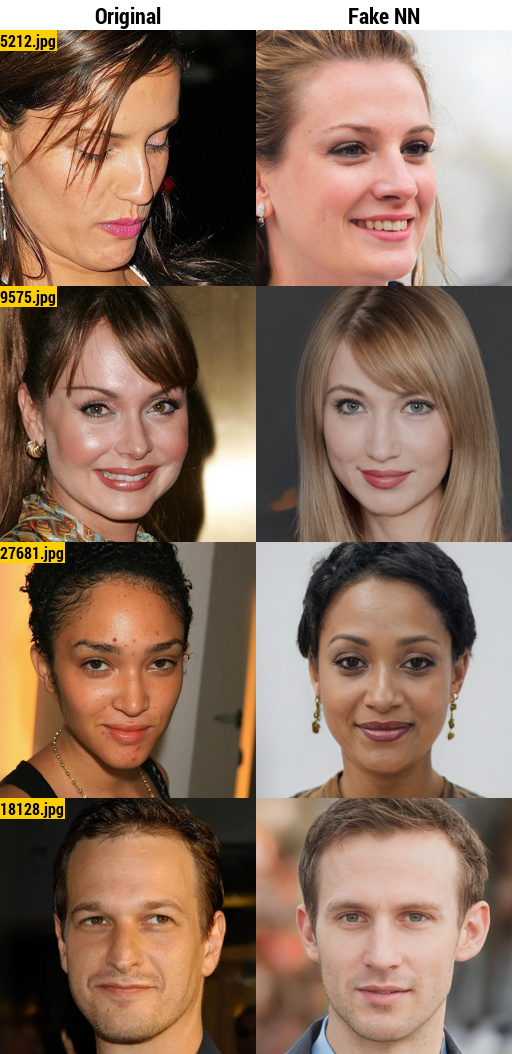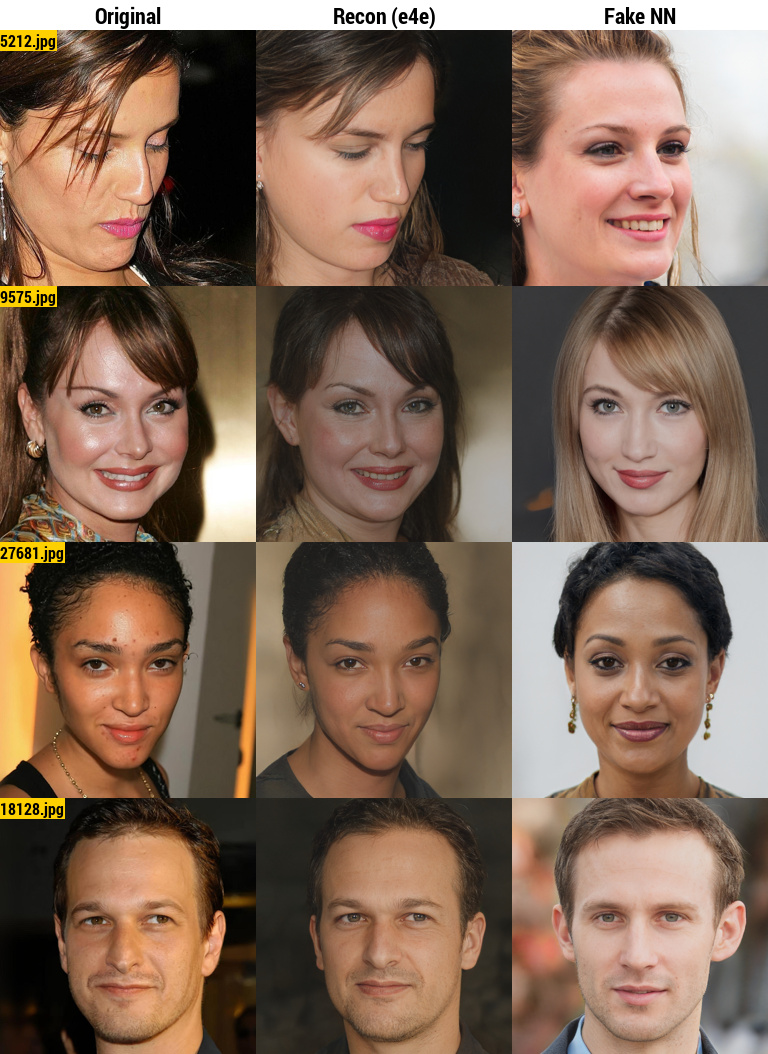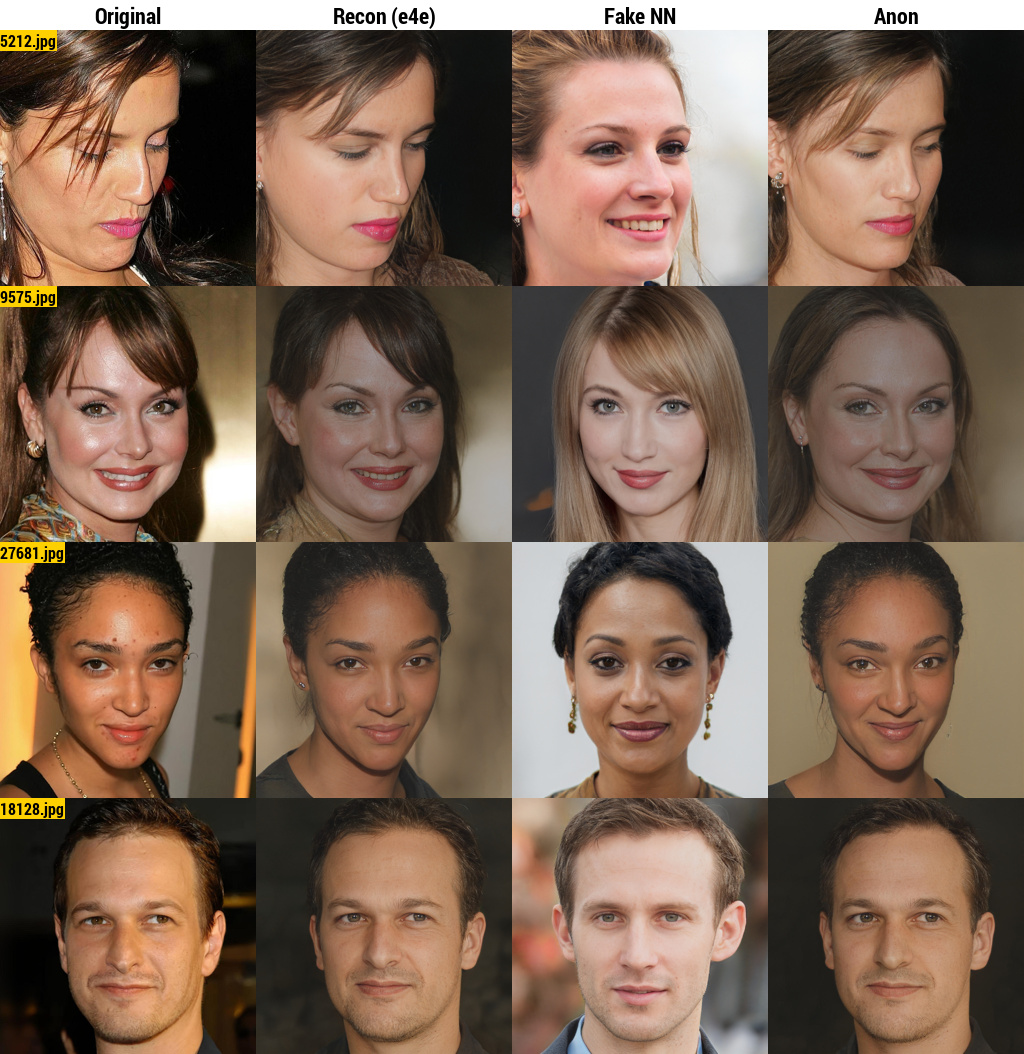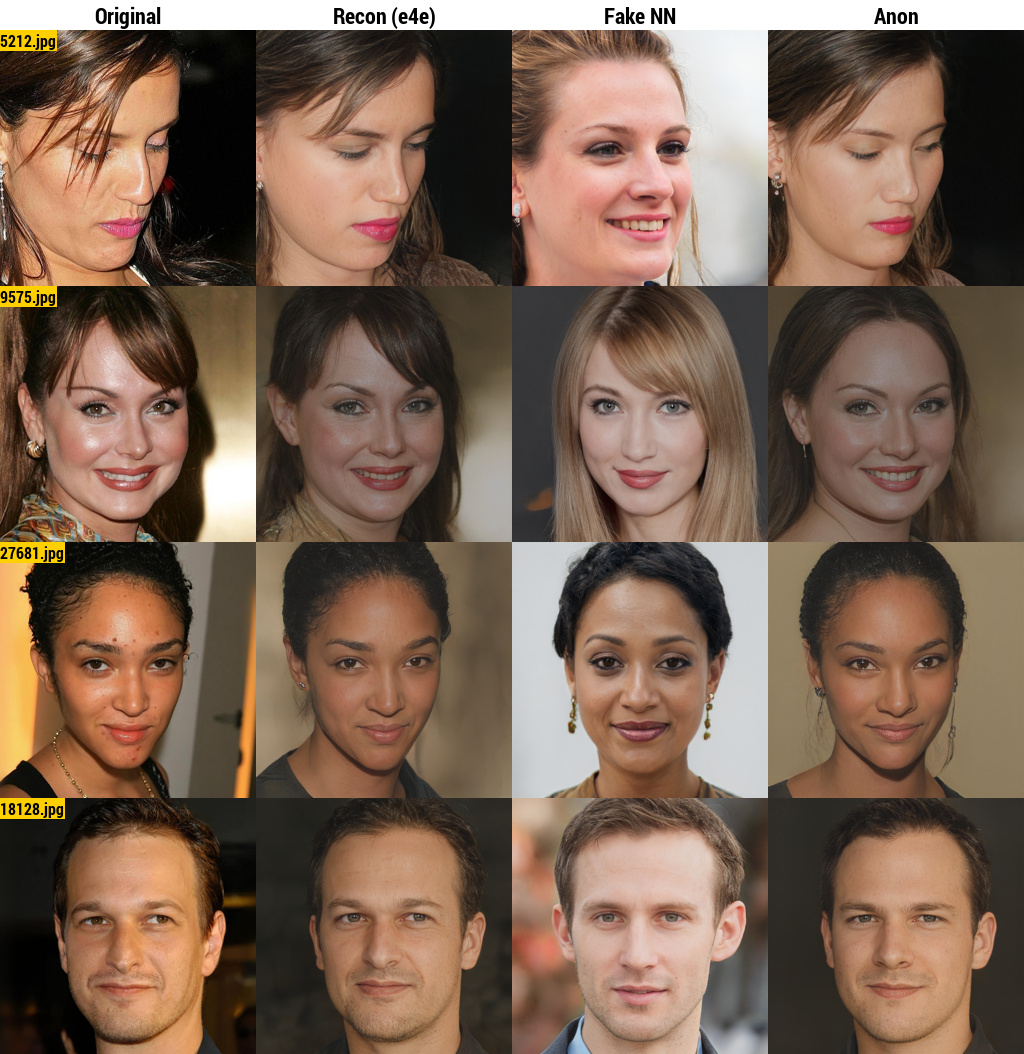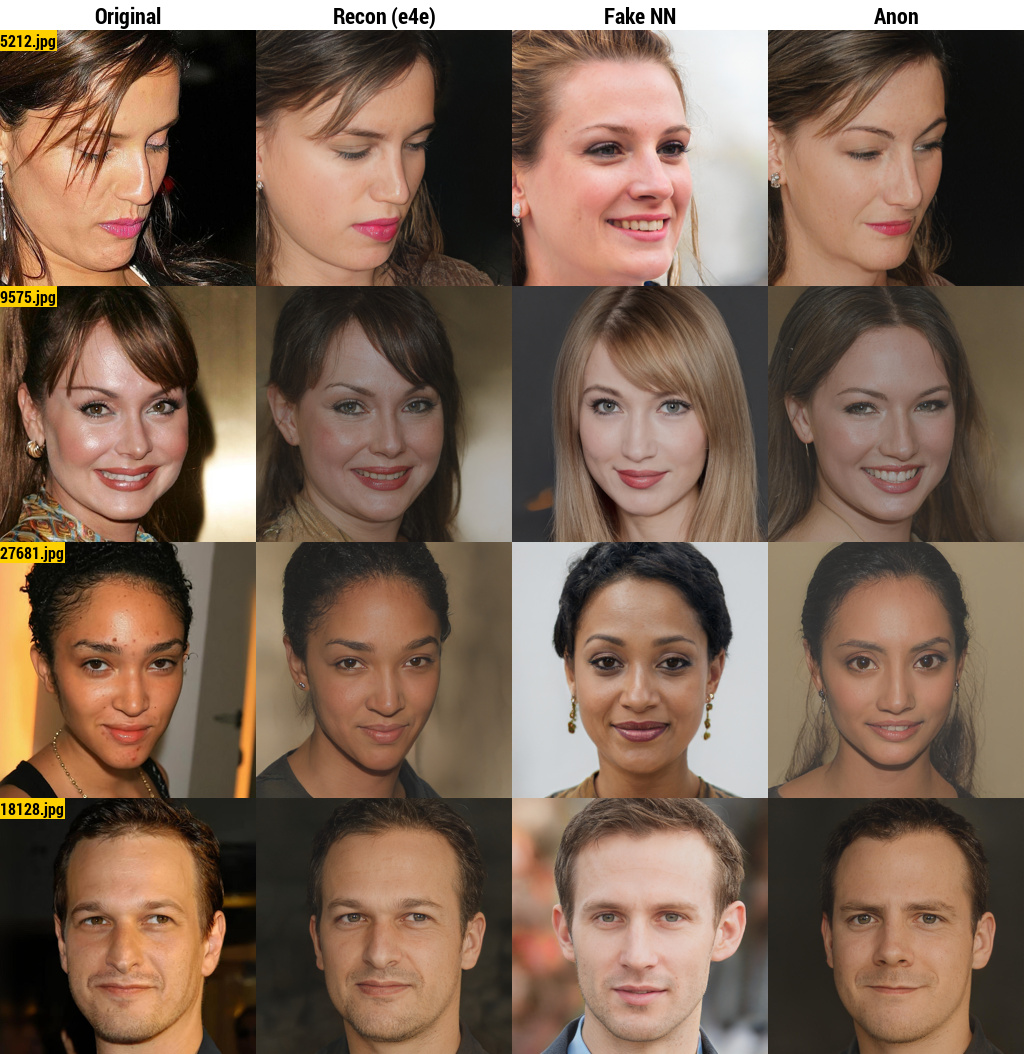Authors official PyTorch implementation of the Attribute-preserving Face Dataset Anonymization via Latent Code Optimization (CVPR 2023, top-10%). If you find this code useful for your research, please cite our paper.
Attribute-preserving Face Dataset Anonymization via Latent Code Optimization
Simone Barattin*, Christos Tzelepis*, Ioannis Patras, and Nicu Sebe (* denotes co-first authorship)
IEEE Conference on Computer Vision and Pattern Recognition (CVPR 2023, highlight/top-10%)Abstract: This work addresses the problem of anonymizing the identity of faces in a dataset of images, such that the privacy of those depicted is not violated, while at the same time the dataset is useful for downstream task such as for training machine learning models. To the best of our knowledge, we are the first to explicitly address this issue and deal with two major drawbacks of the existing state-of-the-art approaches, namely that they (i) require the costly training of additional, purpose-trained neural networks, and/or (ii) fail to retain the facial attributes of the original images in the anonymized counterparts, the preservation of which is of paramount importance for their use in downstream tasks. We accordingly present a task-agnostic anonymization procedure that directly optimises the images' latent representation in the latent space of a \textit{pre-trained} GAN. By optimizing the latent codes directly, we ensure both that the identity is of a desired distance away from the original (with an identity obfuscation loss), whilst preserving the facial attributes (using a novel feature-matching loss in FaRL's deep feature space). We demonstrate through a series of both qualitative and quantitative experiments that our method is capable of anonymizing the identity of the images whilst--crucially--better-preserving the facial attributes.
We recommend installing the required packages using Python's native virtual environment (venv) as follows:
# Create a virtual environment and activate it
python -m venv falco-venv
source falco-venv/bin/activate
# Upgrade pip and install requirements
pip install --upgrade pip
pip install setuptools
pip install -r requirements.txt
# Install pytorch and torchvision (nightly, CUDA 12.1)
pip install --pre torch torchvision torchaudio --index-url https://download.pytorch.org/whl/nightly/cu121
# Install CLIP (for obtaining the CLIP and FaRL ViT features)
pip install git+https://github.com/openai/CLIP.gitFor using the aforementioned virtual environment in a Jupyter Notebook, you need to manually add the kernel as follows:
python -m ipykernel install --user --name=falco-venvDownload the prerequisite pre-trained models (GAN generators [1], e4e inversion encoder [2], SFD face detector [3], FaRL [4], and ArcFace [5]):
python download_models.pyThis will create a directory models/pretrained with the following sub-directories (~3.5 GB):
./models/pretrained/
├── arcface
│ └── model_ir_se50.pt
├── e4e
│ ├── e4e_ffhq_encode.pt
│ ├── model_ir_se50.pth
│ └── shape_predictor_68_face_landmarks.dat
├── farl
│ ├── FaRL-Base-Patch16-LAIONFace20M-ep16.pth
│ └── FaRL-Base-Patch16-LAIONFace20M-ep64.pth
├── genforce
│ ├── stylegan2_ffhq512.pth
│ └── stylegan2_ffhq1024.pth
└── sfd
└── s3fd-619a316812.pth
Not that the required pre-trained CLIP [6] and DINO [7] models will be downloaded automatically upon request.
Please see here for a brief description of each real dataset used and guidelines on how to download and store them.
Extract features (in the CLIP [6] and/or FaRL [4] and/or DINO [7] and/or ArcFace [5] feature spaces) for the images in a given real dataset using the following script:
extract_features.py [-h] [-v] --dataset {celeba,celebahq,lfw} [--dataset-root DATASET_ROOT] [--batch-size BATCH_SIZE] [--no-clip] [--no-farl] [--no-dino] [--no-arcface] [--cuda] [--no-cuda]
Real dataset feature extraction in the CLIP/FaRL/DINO/ArcFace spaces.
options:
-h, --help show this help message and exit
-v, --verbose verbose mode on
--dataset {celeba,celebahq,lfw}
choose real dataset
--dataset-root DATASET_ROOT
set dataset root directory
--batch-size BATCH_SIZE
set batch size
--no-clip do NOT extract CLIP features
--no-farl do NOT extract FaRL features
--no-dino do NOT extract DINO features
--no-arcface do NOT extract ArcFace features
--cuda use CUDA during training
--no-cuda do NOT use CUDA during trainingUpon completion, the features will be stored under datasets/features/<dataset>/ directory. For example,
python extract_features.py -v --dataset=celebahq --batch-size=128will extract all features and store them as follows:
datasets/features/celebahq/
├── arcface_features.pt
├── clip_features.pt
├── dino_features.pt
├── farl_features.pt
└── image_filenames.txtIn order to create a pool of fake images, along with their latent codes in W+/S spaces and feature representations in the CLIP [6] and/or FaRL [4] and/or DINO [7] and/or ArcFace [5] spaces, use the following script:
create_fake_dataset.py [-h] [-v] [--gan {stylegan2_ffhq1024,stylegan2_ffhq512}] [--truncation TRUNCATION] [--num-samples NUM_SAMPLES] [--no-clip] [--no-farl] [--no-dino] [--no-arcface] [--cuda] [--no-cuda]
Create a fake image dataset using a pre-trained GAN generator.
options:
-h, --help show this help message and exit
-v, --verbose verbose mode on
--gan {stylegan2_ffhq1024,stylegan2_ffhq512}
pre-trained GAN generator
--truncation TRUNCATION
W-space truncation parameter
--num-samples NUM_SAMPLES
number of latent codes to sample
--no-clip do NOT extract CLIP features
--no-farl do NOT extract FaRL features
--no-dino do NOT extract DINO features
--no-arcface do NOT extract ArcFace features
--cuda use CUDA during training
--no-cuda do NOT use CUDA during trainingThe generated images along with the corresponding latent codes and features will be stored under datasets/fake/. For example,
python create_fake_dataset.py -v --num-samples=60000will generate 60,000 images/latent codes/features and will store them under datasets/fake/fake_dataset_stylegan2_ffhq1024-0.7-60000-CLIP-FaRL-DINO-ArcFace.
In order to find the nearest fake neighbor of each image in a given real dataset, use the following script:
pair_nn.py [-h] [-v] --real-dataset {celeba,celebahq,lfw} [--fake-dataset-root FAKE_DATASET_ROOT] [--algorithm {auto,ball_tree,kd_tree,brute,all}] [--metric {euclidean,cosine,all}] [--cuda] [--no-cuda]
Pair each image of a given real dataset with an image of a given fake dataset
options:
-h, --help show this help message and exit
-v, --verbose verbose mode on
--real-dataset {celeba,celebahq,lfw}
real dataset
--fake-dataset-root FAKE_DATASET_ROOT
set the fake dataset's root directory (as generated by `create_fake_dataset.py` under datasets/)
--algorithm {auto,ball_tree,kd_tree,brute,all}
set algorithm used to compute the nearest neighbors
--metric {euclidean,cosine,all}
metric to use for distance computation
--cuda use CUDA during training
--no-cuda do NOT use CUDA during trainingUpon completion, NN map files (i.e., dictionaries that map each real image to a fake one) are stored under <fake_dataset_root>.
For example, in order to assign to each image in the CelebA-HQ dataset to a fake NN from the fake dataset created in the example above (i.e., datasets/fake/fake_dataset_stylegan2_ffhq1024-0.7-60000-CLIP-FaRL-DINO-ArcFace/), for all available feature representations (i.e., CLIP [6], FaRL [4], DINO [7], and ArcFace [5]) and using the auto NN algorithm and the euclidean/cosine metrics, run:
python pair_nn.py -v --real-dataset=celebahq --fake-dataset-root=datasets/fake/fake_dataset_stylegan2_ffhq1024-0.7-60000-CLIP-FaRL-DINO-ArcFace/ --algorithm=autoUpon completion the following files will be stored under datasets/fake/fake_dataset_stylegan2_ffhq1024-0.7-60000-CLIP-FaRL-DINO-ArcFace/:
datasets/fake_dataset_stylegan2_ffhq1024-0.7-60000-CLIP-FaRL-DINO-ArcFace/arcface_auto_euclidean_nn_map_celebahq.json
datasets/fake_dataset_stylegan2_ffhq1024-0.7-60000-CLIP-FaRL-DINO-ArcFace/clip_auto_euclidean_nn_map_celebahq.json
datasets/fake_dataset_stylegan2_ffhq1024-0.7-60000-CLIP-FaRL-DINO-ArcFace/dino_auto_euclidean_nn_map_celebahq.json
datasets/fake_dataset_stylegan2_ffhq1024-0.7-60000-CLIP-FaRL-DINO-ArcFace/farl_auto_euclidean_nn_map_celebahq.json
datasets/fake_dataset_stylegan2_ffhq1024-0.7-60000-CLIP-FaRL-DINO-ArcFace/arcface_auto_cosine_nn_map_celebahq.json
datasets/fake_dataset_stylegan2_ffhq1024-0.7-60000-CLIP-FaRL-DINO-ArcFace/clip_auto_cosine_nn_map_celebahq.json
datasets/fake_dataset_stylegan2_ffhq1024-0.7-60000-CLIP-FaRL-DINO-ArcFace/dino_auto_cosine_nn_map_celebahq.json
datasets/fake_dataset_stylegan2_ffhq1024-0.7-60000-CLIP-FaRL-DINO-ArcFace/farl_auto_cosine_nn_map_celebahq.jsonIn case you get the following error,
OpenBLAS warning: precompiled NUM_THREADS exceeded, adding auxiliary array for thread metadata.
OpenBLAS : Program is Terminated. Because you tried to allocate too many memory regions. This library was built to support a maximum of 128 threads - either rebuild OpenBLAS with a larger NUM_THREADS value or set the environment variable OPENBLAS_NUM_THREADS to a sufficiently small number. This error typically occurs when the software that relies on OpenBLAS calls BLAS functions from many threads in parallel, or when your computer has more cpu cores than what OpenBLAS was configured to handle. OpenBLAS : Program is Terminated. Because you tried to allocate too many memory regions.
try to set OPENBLAS_NUM_THREADS to a sufficiently small number, e.g., OPENBLAS_NUM_THREADS=32 and re-run as follows:
OPENBLAS_NUM_THREADS=32 python pair_nn.py -v --real-dataset=celebahq --fake-dataset-root=datasets/fake/fake_dataset_stylegan2_ffhq1024-0.7-60000-CLIP-FaRL-DINO-ArcFace/ --algorithm=autoNote that at this point, you may visualize the real dataset along with its NN fake images using the visualization script shown below (i.e., visualize_dataset.py). For example, using the fake dataset generated in the above examples, you may visualize the CelebA-HQ dataset along with fake NNs found in the FaRL features space as follows:
python visualize_dataset.py -v --dataset=celebahq --fake-nn-map=datasets/fake/fake_dataset_stylegan2_ffhq1024-0.7-60000-CLIP-FaRL-DINO-ArcFace/farl_auto_cosine_nn_map_celebahq.jsonIn order to invert the images of a given real dataset, use the following script:
invert.py [-h] [-v] --dataset {celeba,celebahq,lfw} [--dataset-root DATASET_ROOT] [--batch-size BATCH_SIZE] [--save-aligned-images] [--dont-save-aligned-images]
[--save-reconstructed-images] [--dont-save-reconstructed-images] [--cuda] [--no-cuda]
Real dataset GAN inversion script.
options:
-h, --help show this help message and exit
-v, --verbose verbose mode on
--dataset {celeba,celebahq,lfw}
choose real dataset
--dataset-root DATASET_ROOT
set dataset root directory
--batch-size BATCH_SIZE
set generation batch size
--save-aligned-images
save aligned images
--dont-save-aligned-images
do NOT save aligned images
--save-reconstructed-images
save reconstructed images
--dont-save-reconstructed-images
do NOT save reconstructed images
--cuda use CUDA during training
--no-cuda do NOT use CUDA during trainingUpon completion, the inverted dataset are stored under <dataset_root>/inv/ following the structure of the original real dataset. For example, in order to invert the CelebA-HQ dataset, run:
python invert.py -v --dataset=celebahqGiven that CelebA-HQ is stored under datasets/CelebA-HQ, the inverted dataset will be stored under datasets/inv/celebahq/.
Note that at this point, you may visualize the real dataset along with its e4e inversions and NN fake images using the visualization script shown below (i.e., visualize_dataset.py). For example, using the fake dataset generated in the above examples, you may visualize the CelebA-HQ dataset along with its inversions and fake NNs found in the FaRL features space as follows:
python visualize_dataset.py -v --dataset=celebahq --fake-nn-map=datasets/fake/fake_dataset_stylegan2_ffhq1024-0.7-60000-CLIP-FaRL-DINO-ArcFace/farl_auto_cosine_nn_map_celebahq.json --invIn order to anonymize the images of a given real dataset, use the following script:
anonymize.py [-h] [-v] --dataset {celeba,celebahq,lfw} [--dataset-root DATASET_ROOT] [--subset {train,val,test,train+val,train+val+test}] --fake-nn-map FAKE_NN_MAP
[--latent-space {W+,S}] [-m ID_MARGIN] [--epochs EPOCHS] [--optim {sgd,adam}] [--lr LR] [--lr-milestones LR_MILESTONES [LR_MILESTONES ...]]
[--lr-gamma LR_GAMMA] [--lambda-id LAMBDA_ID] [--lambda-attr LAMBDA_ATTR] [--cuda] [--no-cuda]
options:
-h, --help show this help message and exit
-v, --verbose verbose mode on
--dataset {celeba,celebahq,lfw}
choose real dataset
--dataset-root DATASET_ROOT
set dataset root directory
--subset {train,val,test,train+val,train+val+test}
choose dataset's subset
--fake-nn-map FAKE_NN_MAP
fake NN map file (created by `pair_nn.py`)
--latent-space {W+,S}
StyleGAN2's latent space
-m ID_MARGIN, --id-margin ID_MARGIN
identity loss margin
--epochs EPOCHS Number of anonymization steps
--optim {sgd,adam} set optimizer ('sgd' or 'adam')
--lr LR Learning rate
--lr-milestones LR_MILESTONES [LR_MILESTONES ...]
learning rate scheduler milestones
--lr-gamma LR_GAMMA learning rate decay parameter
--lambda-id LAMBDA_ID
Scaling parameter of the ID loss
--lambda-attr LAMBDA_ATTR
Scaling parameter of the attribute loss
--cuda use CUDA during training
--no-cuda do NOT use CUDA during trainingUpon completion, the anonymized dataset are stored under <dataset_root>/anon/ following the structure of the original real dataset.
Note that at this point, you may visualize the real dataset along with its e4e inversions, the NN fake images, and the anonymized images using the visualization script shown below (i.e., visualize_dataset.py). For example, using the fake dataset generated in the above examples, you may visualize the CelebA-HQ dataset along with its inversions, the fake NNs found in the FaRL features space, and the anonymized images as follows:
python visualize_dataset.py -v --dataset=celebahq --fake-nn-map=datasets/fake/fake_dataset_stylegan2_ffhq1024-0.7-60000-CLIP-FaRL-DINO-ArcFace/farl_auto_cosine_nn_map_celebahq.json --inv --anon=datasets/anon/celebahq/celebahq-train+val+test_anon_W+_m-0.5_lambda-id-10.0_lambda-attr-0.1_adam-0.01_epochs-50_farl_auto_cosine_nn_map_celebahq/@inproceedings{barattin2023attribute,
title={Attribute-preserving Face Dataset Anonymization via Latent Code Optimization},
author={Barattin, Simone and Tzelepis, Christos and Patras, Ioannis and Sebe, Nicu},
booktitle={Proceedings of the IEEE/CVF Conference on Computer Vision and Pattern Recognition},
pages={8001--8010},
year={2023}
}[1] https://genforce.github.io/
[2] Tov, O., Alaluf, Y., Nitzan, Y., Patashnik, O., & Cohen-Or, D. (2021). Designing an encoder for stylegan image manipulation. ACM Transactions on Graphics (TOG), 40(4), 1-14.
[3] Zhang, S., Zhu, X., Lei, Z., Shi, H., Wang, X., & Li, S. Z. (2017). S3fd: Single shot scale-invariant face detector. In Proceedings of the IEEE international conference on computer vision (pp. 192-201).
[4] Zheng, Y., Yang, H., Zhang, T., Bao, J., Chen, D., Huang, Y., ... & Wen, F. (2022). General facial representation learning in a visual-linguistic manner. In Proceedings of the IEEE/CVF Conference on Computer Vision and Pattern Recognition (pp. 18697-18709).
[5] Deng, J., Guo, J., Xue, N., & Zafeiriou, S. (2019). Arcface: Additive angular margin loss for deep face recognition. In Proceedings of the IEEE/CVF conference on computer vision and pattern recognition (pp. 4690-4699).
[6] Radford, A., Kim, J. W., Hallacy, C., Ramesh, A., Goh, G., Agarwal, S., ... & Sutskever, I. (2021, July). Learning transferable visual models from natural language supervision. In International conference on machine learning (pp. 8748-8763). PMLR.
[7] Caron, M., Touvron, H., Misra, I., Jégou, H., Mairal, J., Bojanowski, P., & Joulin, A. (2021). Emerging properties in self-supervised vision transformers. In Proceedings of the IEEE/CVF international conference on computer vision (pp. 9650-9660).
This research was supported by the EU's Horizon 2020 programme H2020-951911 AI4Media project.


